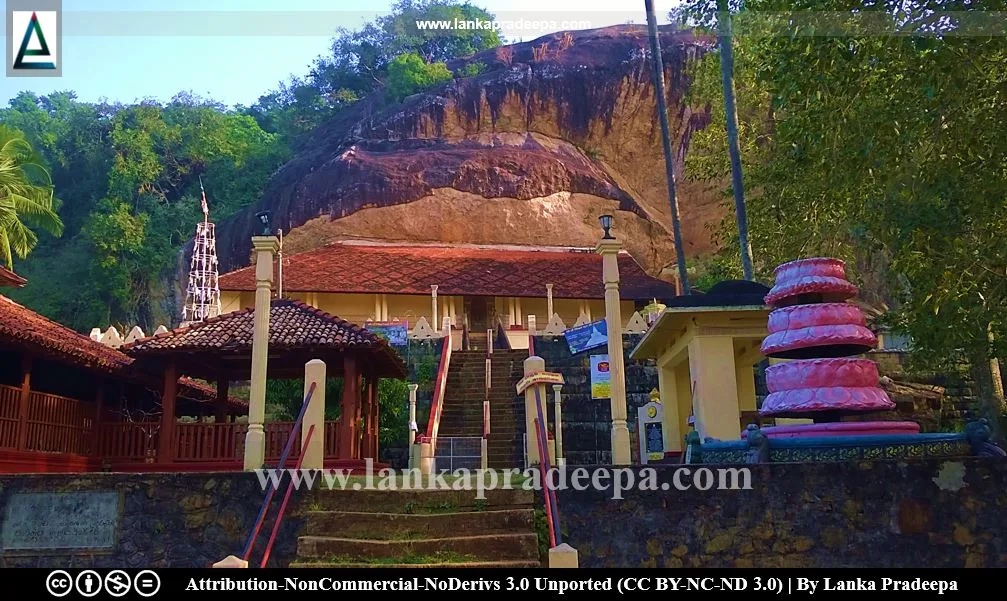Veramune Sri Sundararama Viharaya, popularly known as Meddepola Raja Maha Viharaya (Sinhala: වේරමුණේ ශ්රී සුන්දරාරාම විහාරය, මැද්දේපොල විහාරය) is an ancient Buddhist temple located in Meddepola village in Kurunegala District, Sri Lanka. The site can be reached by travelling along the Meddepola temple road about 2.2 km distance from Giriulla town.
Etymology
"Muni Vehera" was the ancient name used to identify this temple. It was later converted to "Vehera Muni" and finally evolved to the present name "Veramune". However, the temple is popularly known among the people as Meddepola Viharaya.
History
The origin of the Meddepola temple is linked by the locals to the reign of King Devanampiya Tissa (247-207 B.C.). An Early Brahmi Inscription has been found below the drip-ledge of the main cave that houses the image house today. Another such inscription is said to have been found in a drip-ledged cave located southwestern to the main cave (Anuradha & Kumari, 2015).
Meddepola Cave Inscription
Period: 3rd century B.C. - 1st century A.D. Script: Early Brahmi Language: Old Sinhala
Transcript: Shumana data (te)rasha gahapa (..) shaha lene
Translation: Cave of the elder Sumanadatta and of householder ....sa.
Reference: Wijesekara, 1990.
The temple is said to have been renovated and developed under the patronage of several kings including Valagamba (103, 87-77 B.C.) and Parakramabahu II (1234 - 1269 A.D.). The Culavamsa, the latter part of Mahavamsa, mentions that King Kirti Sri Rajasinghe (1742-1782 A.D.) had restored the Meddepola temple in the 18th century [Livingstone & Withers (eds.), 2011]. A copper plate grant issued by Kirti Sri Rajasinha reveals a donation of land from Malgamuwa village to Ginigathpitiye Deepankara Thera, the then incumbent of Meddepola Viharaya.
The construction works of the image house (the cave temple) were completed in 1844, by Kadahapola Sangharakkhitha Sri Medhankara Thera (Anuradha & Kumari, 2015; De Silva & Chandrasekara, 2009). The original paintings that adorn the inner walls of the image house have been done by the artists headed by Devaragampola Silvath Thena and belong to the Kandyan tradition. However, most of the paintings remaining today are recent works of two modern painters, Soliyas Mendis, and S. J. S. Silva.
The Preaching Hall

Several historical sources reveal that the preaching hall of Meddepola temple was constructed during the reign of King Kirti Sri Rajasinghe (De Silva & Chandrasekara, 2009).
This building bears typical architectural features belonging to the Kandyan Period. Some of the modifications have been done to the building in 1992 (De Silva & Chandrasekara, 2009).
The Museum
A large number of antiquities belonging to the temple can be seen conserved in a museum established at the temple premises. Many important objects, such as a gold statue donated by a king, silver and ivory statues, caskets, ola manuscripts, coins, ceramics from the Dutch period, and clothes, such as Somanas are found preserved in the museum (Rambukwella, 2014).
A Protected Site
The drip-ledged cave temple with Brahmi letters, ancient Dhammasala (preaching hall), Pohoya Geya (Bhikkus disciplinary hall), Bhikkus residence (dwelling house), and drip-ledged caves belonging to the Weramune Sri Sunandarama Raja Maha Vihara premises situated in the Grama Niladhari Division of Ihala Meddepola in the Divisional Secretary’s Division of Pannala are archaeological protected monuments, declared by the government gazette notifications published on 23 January 2009 and 24 July 2009.




References
1) Anuradha, R.K.S.; Kumari, A.S., 2015. Pauranika Sthana Ha Smaraka: Kurunegala Distrikkaya (In Sinhala). Department of Archaeology. ISBN: 955-9159-37-2. pp.82-83.
2) De Silva, N.; Chandrasekara, D.P., 2009. Heritage Buildings of Sri Lanka. Colombo: The National Trust Sri Lanka, ISBN: 978-955-0093-01-4. pp.75,89,105.
3) Livingstone, D.N. and Withers, C.W. eds., 2011. Geographies of nineteenth-century science. University of Chicago Press. p.126.
4) Rambukwella, M.W.C.N.K., 2014. Heritage representation in culturally diverse societies: a case study of the Colombo National Museum in Sri Lanka (Doctoral dissertation, School of Museum Studies). pp.362-363.
5) The Gazette of the Democratic Socialist Republic of Sri Lanka. No: 1586. 23 January 2009. p.106.
6) The Gazette of the Democratic Socialist Republic of Sri Lanka. No: 1612. 24 July 2009. p.1023.
7) Wijesekara, N. (Editor in chief)], 1990. Archaeological Department Centenary (1890-1990): Commemorative Series: Vol. II: Inscriptions. p.45.
Explore Other Nearby Attractions
Responsive esri Map
Responsive Google Map
මැද්දේපොළ රජමහා විහාරය
මැද්දේපොළ රජමහා විහාරය හෝ වේරමුණේ ශ්රී සුන්දරාරාම විහාරය ශ්රී ලංකාවේ කුරුණෑගල දිස්ත්රික්කය තුල පිහිටි විහාරස්ථානයකි.
ඉතිහාසය
මුණි වෙහෙර යනු මෙම විහාරය හැඳින්වීමට අතීතයේ භාවිත කල නාමය වේ. එය පසුකාලීනව වෙහෙර මුණි බවටත් අවසානයේ වේරමුණේ බවටත් පත්ව ඇත. විහාරයේ ඉතිහාසය ප්රාදේශීය ජනයා විසින් දේවානම්පියතිස්ස රජ සමයට (ක්රි.පූ. 307-267) සම්බන්ධ කරයි. වත්මන් ලෙන් විහාරයේ කටාරමට යටින් කොටවන ලද ක්රි. පූ යුගයට අයත්විය හැකි බ්රාහ්මී අක්ෂරයෙන් රචිත ලෙන් ලිපියක් දැකගත හැකිවන අතර තවත් එවැනි ලිපියක් ඊට නිරිත දිශාවෙන් පිහිටි කටාරම් කෙටූ ලෙනක හමුවෙයි.
විහාරය වළගම්බා (ක්රි.පූ. 103,87-77) හා 2වන පරාක්රමබාහු වැනි රජවරුන්ගේ අනුග්රහය යටතේ ප්රතිසංස්කරණයට හා සංවර්ධනයට ලක්වූ බව පැවසෙයි. දහඅටවන සියවසෙහි පමණ රචිත චූලවංශයෙහි දැක්වෙන ආකාරයට කීර්ති ශ්රී රාජසිංහ රජු (ක්රි.ව. 1742-1782) විසින් මැද්දේපොළ විහාරය ප්රතිසංස්කරණය කොට ඇත. එසේම රජු විසින් නිකුත් කෙරූ තඹපත් ප්රධානයකින්, එවක මැද්දේපොළ විහාරයේ විහාරාධිපති වූ ගිනිගත්පිටියේ දීපංකර තෙරණුවන්ට මල්ගමුව ග්රාමයෙන් ලබා දුන් දේපලක් පිළිබඳව තොරතුරු හෙළිදරව් කරයි.
වත්මන් ලෙන් විහාරයෙහි වැඩකටයුතු කඩහපොළ සංඝරක්ඛිත ශ්රී මේධංකර තෙරණුවන් විසින් 1844දී සම්පූර්ණ කර තිබේ. එහි ඇතුල් බිත්ති සරසන මුල්ම සිතුවම් නුවර සම්ප්රදායට අයත්වන අතර ඒවා දෙවරගම්පල සිල්වත් තැන ප්රමුඛ සිත්තරුන් විසින් නිමවා ඇත. කෙසේනමුදු, වත්මන් ලෙන් විහාරයේ දැකගත හැකි සිතුවම් බොහොමයක් නිමවා ඇත්තේ සෝලියස් මැන්දිස් හා එස්.ජේ. එස්. සිල්වා යන සිත්තරුන් දෙදෙනා විසිනි.
පුරාවිද්යා ස්මාරක ස්ථානය
පන්නල ප්රාදේශීය ලේකම් කොට්ඨාශයේ ඉහල මැද්දේපොළ ග්රාමනිළදාරී වසමට අයත් වේරමුණේ ශ්රී සුන්දරාරාම විහාර පරිශ්රයෙහි වූ බ්රාහ්මී අක්ෂර සහිත කටාරම් කෙටූ ලෙන් විහාරය, පැරණි ධර්ම ශාලාව, පොහොය ගෙය, භික්ෂු ආවාසය හා කටාරම් කෙටූ ලෙන් 2009 ජනවාරි 23 හා 2009 ජූලි 24දින ප්රකාශයට පත් රජයේ ගැසට් නිවේදන මගින් ආරක්ෂිත පුරාවිද්යා ස්මාරක ලෙස නම් කොට ඇත.


